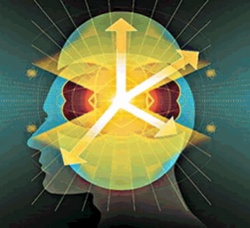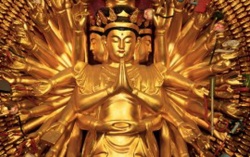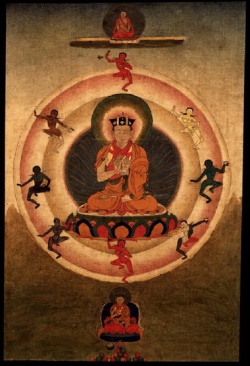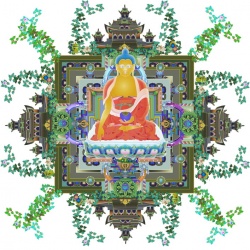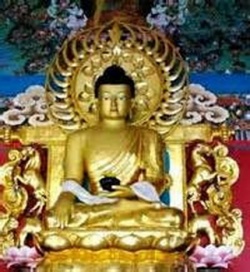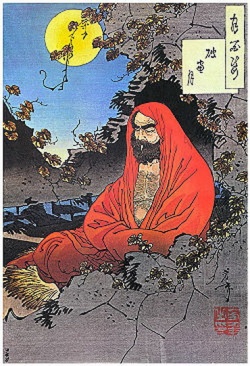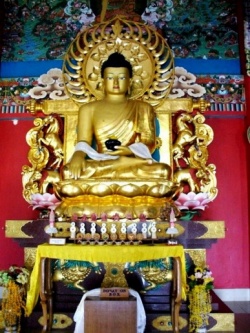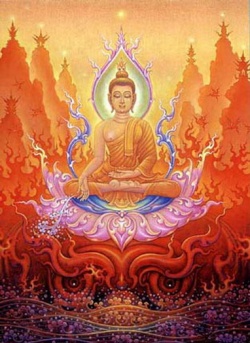How the Universe and First Beings Were Created
“Bhikkhus, in the whole world with its Gods, Mara and Brahma, in this generation with its ascetics and brahmins, Gods and humans, the greatest being is the conqueror, unconquered, one who sees-at-will, the wielder of power. He is called the Great Being. By comprehending all the world - all in the world just as it is – then from all the world he is liberated”1
The above quote from the Loka2 Sutta captures the importance of understanding the nature of the universe and all that is in it to achieve spiritual liberation from the things that cause us to suffer – the ultimate goal in Buddhism. The Buddha spoke frequently about planes of existence in the universe and the beings residing there, and many of these discourses help us understand how and why beings are born in the various realms of existence – including the human realm. The universe as a whole merely reflects the rebirth results of actions performed as a human being, and therefore knowing how the universe functions to accommodate various life forms will aid us in understanding who we are, where we came from, and where we will go after the death of the body.
Nearly all of us who have been exposed to the Judeo-Christian Bible are familiar with the “God created the Earth in seven days” story in Genesis. And some of us may be familiar with the creation stories in the Quran and Hindu scriptures. But not many of us are fully aware of the Buddhist creation story, which features a cyclical expanding and contracting universe, and first beings on Earth who were former Gods3 who used to reside in heavenly realms but exhausted their kamma (Skt.: “karma”) from their previous lives as humans. Thus, the “fallen God” concept is actually part of the Buddhist creation story, in which Gods rise and fall based on their kamma (i.e., sum total of intentions and actions, and the clinging and aversion to sense objects that drive them) and the exhaustion of it.
Aggañña Sutta
The main discourse where the Buddhist creation story appears is in the Aggañña4 Sutta of the Digha Nikaya.5 Here, the Buddha describes beings 'mostly' preserved in the heavenly realm of Streaming Radiance (Ābhassara) during the contraction of the universe. A small percentage of beings are actually reborn into heaven realms higher than Streaming Radiance during the contraction cycle of the universe based on their kamma, the removal of fetters6 that bind them to samsāra (i.e., cycle of birth, death, and rebirth), or the attainment of meditative jhāna7 states. The heaven realms of Streaming Radiance and above are sufficiently high that they are outside and independent of the gross material of the universe that is contracting, and are considered “fine material” heavenly realms of existence where beings have fine material bodies of light:8
“There comes a time, Vasettha, when, sooner or later after a long period, this (universe) contracts. At a time of contraction, beings are mostly born in the Ābhassara Brahma world. And there they dwell, mind-made, feeding on delight, self-luminous, moving through the air, glorious — and they stay like that for a very long time. But sooner or later, after a very long period, [the universe) begins to expand again. At a time of expansion, the beings from the Ābhassara Brahma world, having passed away from there, are mostly reborn in this world (Earth-like worlds). Here they dwell, mind-made, feeding on (bliss), self-luminous, moving through the air, glorious--and they stay like that for a very long time.”
The Buddha explains that the first beings appearing on Earth after one of the expansion cycles of the universe are mind-made beings of light that fell from the heavenly realm of Streaming Radiance. The idea of a cyclical expanding and contracting universe had been dismissed by most scientists until recently, as the universe as currently observed is simply expanding. The most powerful telescopes, for example, can see this expansion clearly going back in time all the way to what is thought to be the Big Bang, but these telescopes obviously cannot see what happened before the Big Bang. Fairly recent scientific studies, however, are beginning to confirm what the Buddha said 2,600 years ago without the aid of modern scientific tools, that the universe may well have collapsed before the Big Bang as part of a cyclical process.9 The passage above also indicates that these first beings of light were “feeding on bliss” (mind-based pleasure) typical of beings residing in the Ābhassara realm, but this greater sense-based pleasure was not 'earned' in their previous life as a human based on their kamma, which causes them to fall when the universe expands again.
“At that period, Vasettha, there was just one mass of water, and all was darkness, blinding darkness. Neither moon nor sun appeared, no constellations or stars appeared, night and day were not distinguished, nor months and fortnights, no years or seasons, and no male and female, beings being reckoned just as beings.”
There is no explanation given for such complete darkness, but sunlight and stars may not have been visible from the Earth’s surface due to hydrogen clouds, dust and debris from collisions with asteroids and protoplanets, and volcanic ash from the thousands of active volcanoes which were common during the early period of Earth’s formation. This passage also clearly indicates that the Gods that came to Earth as first beings from the Streaming Radiance heavenly realm in Buddhism had no male/female distinction. If 'higher' beings have no sexual distinction, it certainly is peculiar to emphasize and attach too much importance to sexual identity as humans do in this era. This may explain why the Buddha decided to admit women into the monastic order more than two thousand years before women's suffrage and the equal rights movement, as reflection on his own former lives as a God would crystallize the complete irrelevance of sexual identity in higher beings and in attaining spiritual liberation from the cause of human suffering.
“And sooner or later, after a very long period of time, savoury earth spread itself over the waters where those beings were. It looked just like the skin that forms itself over hot milk as it cools. It was endowed with colour, smell and taste. It was the colour of fine ghee or butter, and it was very sweet, like pure wild honey.”
The best scientific candidate for “savory earth” that spread over the waters during the Earth's early history would be some sort of phytoplankton like cyanobacteria that appears on the surface of the ocean and feeds off light with oxygen as its 'waste' product. Cyanobacteria were present on the surface of the ocean starting about 3.5 billion years ago according fossils found in very old rocks.10 We typically see cyanobacteria as a greenish-blue color today, but a yellow ghee color of this plankton has also been found, especially in geothermal pools like the ones in Yellowstone National Park in the U.S.A. This yellow color may have been more prevalent in a less oxygen rich early Earth environment where the oceans were probably much warmer due to massive geothermal and volcanic activity. Although the origin of cyanobacteria is unknown, a similar type of bacteria has recently been found fossilized in Martian rocks on the Earth, and this may well have been an extra-terrestrial life seed that was present in protoplanets and asteroids that bombarded the Earth during its early formation 3-4 billion years ago.
”Then some being of a greedy nature said: 'I say, what can this be?' and tasted the savoury earth on its finger. In so doing, it became taken with the flavour, and craving arose in it. Then other beings, taking their cue from that one, also tasted the stuff with their fingers. They too were taken with the flavour, and craving arose in them. So they set to it with their hands, [tearing] off pieces of the stuff in order to eat it. And the result of this was that their self-luminance disappeared.”11
It seems to be suggested that going outside of oneself for gratification from contact with a sense object is what caused these first beings to lose their luminescence, but it may well be the case that the cyanobacteria that these first beings eventually feasted on from the ocean's surface sapped the light from these first beings. Consuming intense light through photosynthesis was the only way this cyanobacteria could produce its own food, and the collective light from these first beings may have been the only widespread intense light12 available during this early darkness period of the Earth's development.
“And as a result of the disappearance of their self-luminance, the moon and the sun appeared, night and day were distinguished, months and fortnights appeared, and the year and its seasons. To that extent the world re-evolved.”
It is intriguing to contemplate how the darkness on the Earth’s surface became light after these first beings lost their luminescence by feasting on the substance on the surface of the ocean. If cyanobacteria was the substance they were feeding on, its rapid spread through photosynthesis of the light from these first beings produced rapidly spreading oxygen as a waste product, which was a key element in the formation of the Earth's early atmosphere and ozone layer. Because oxygen is denser than the mostly hydrogen interstellar dust clouds, the new oxygen rich atmosphere would have dispersed the much lighter interstellar dust by literally pushing it up and out of the way because of its higher density and volume, allowing the light from the sun, moon, and stars to become visible from the Earth's surface.
“And those beings continued for a very long time feasting on this savoury earth, feeding on it and being nourished by it. And as they did so, their bodies became coarser, and a difference in looks developed among them. Some beings became good-looking, others ugly. And the good-looking ones despised the others, saying: 'We are better-looking, than they are.' And because they became arrogant and conceited about their looks, the savoury earth disappeared.”
The feeding on the substance on the ocean was therefore of a decidedly different character than the 'feeding on bliss' the first beings had been doing previously. It was not simply the exhaustion of previously earned kamma in a previous life as a human, but the creation of new unwholesome kamma rooted in lust for sense objects purely to satisfy the sense of taste rather than for sustenance. The other interesting feature of feasting on the substance of the Earth is that it made their bodies coarser with some bodies appearing more or less handsome, causing conceit. Conceit, the eighth fetter of the 10 fetters that bind beings to samsāra, causes the food from the Earth to disappear for a time. Conceit is also the root of later efforts to separate human beings along economic and even intellectual lines.
What would a being coarser than light that feeds on cyanobacteria on the surface of the ocean look like? It would probably look like a noctiluca scintillan, salp, pyrosome or chaetognatha, which are transparent, jelly-like and sometimes bio-luminescent (self-luminous) aquatic beings that feed on cyanobacteria in the ocean. Noctiluca scintillans are single cell, and perhaps ancestors to the multi-cell salp, pyrosome, and chaetognatha. They are disc shaped and light up the surface of the ocean at night when in large groups. Some scientists say that humans evolved from salps as they were the earliest vertebrate animals on Earth with organs, a respiratory and nervous system, mouth and anus.13 The fact that noctiluca scintillans, pyrosomes, and some salps and chaetognaths are also bio-luminescent is interesting, as some remainder of bio-luminescent capability would be expected if their origin is in fact self-luminous, extra-terrestrial beings.
"And then, when the savoury earth had disappeared, a fungus cropped up, in the manner of a mushroom. It was of a good colour, smell, and taste. It was the colour of fine ghee or butter, and it was very sweet, like pure wild honey. And those beings set to and ate the fungus. And this lasted for a very long time. And as they continued to feed on the fungus, so their bodies became coarser still, and the difference in their looks increased still more. And the good-looking ones despised the others. . . And because they became arrogant and conceited about their looks, the sweet fungus disappeared. Next, creepers appeared, shooting up like bamboo. . . , and they too were very sweet, like pure wild honey. And those beings set to and fed on those creepers. And as they did so, their bodies became even coarser, and the difference in their looks increased still more. . . And they became still more arrogant, and so the creepers disappeared too.”
The earliest fossilized record of mushrooms on Earth are about 100 million years ago, and while there were mushrooms on the ocean floor, it appears that these beings “evolved” at this point and are now feasting on food from land. This would particularly be the case with feasting on creepers which “shoot up like bamboo”, as this implies some sort of grape-like vine that grows upward like the Parthenocissus. The earliest recorded fossilized creepers date to the Paleocene period about 60 million years ago.14
“And then, after the creepers had disappeared, rice appeared in open spaces, free from powder and from husks, fragrant and clean-grained. And what they had taken in the evening for supper had grown again and was ripe in the morning, and what they had taken in the morning for breakfast was ripe again by evening, with no sign of reaping. And these beings set to and fed on this rice, and this lasted for a very long time. And as they did so, their bodies became coarser still, and the difference in their looks became even greater. And the females developed female sex-organs, and the males developed male organs. And the women became excessively preoccupied with men, and the men with women. Owing to this excessive preoccupation with each other, passion was aroused, and their bodies burnt with lust. And later, because of this burning, they indulged in sexual activity.”
This passage makes the Buddhist creation story much like the story of Adam in the Bible and Quran who ate and lusted after the forbidden fruit and then began to notice his nakedness. The forbidden fruit in the Buddhist creation story appears to be successively coarser forms of food on the Earth consumed over a very long period of time until sexual distinctions became apparent. The gradual development of coarser physical attributes in beings with the consumption of coarser food in the Aggañña Sutta implies some sort of physical evolution accompanied by moral devolution. As indicated above, it certainly appears to be the case that the less coarse early beings were probably non-humans of some sort, like noctiluca scintillan, pyrosome, salp or chaetognatha, which would allow for “evolution” into human beings.
The Buddha also appears to be introducing the concept of sustainability and how this is threatened by lust, greed, and artificial separation from other beings based on conceit. One food source disappearing after another doesn't appear to be total extinction of the food source but a substantial reduction in its availability which could no longer sustain mass consumption. Botanical evolution of many other plants not mentioned in the sutta as a principal food source would have continued to produce sufficient oxygen to maintain the Earth’s atmosphere and evolving biodiversity, despite the “disappearance” of any plant food source due to over-consumption. This continuation of one coarser food source after another seems to be driven by craving and lust, which takes beings into lower coarser forms to accommodate the increase in craving. Rice appears to be the first food substance where physical sustenance was the prime motivation for consuming the food, and the lust for taste in food was replaced by sexual lust.
The subtle question presented here by the Buddha is whether more complex beings with ultimate destructive power over other beings are 'superior' to less complex beings with less coarse bodies who are more equanimous, less conceited or separate from other beings, less lustful, less greedy, feed on their own substance, and are in harmony with nature. Darwinian fixations have created the illusion that ultimate destructive power over other life forms makes one superior, when in fact such destruction may be undermining our own physical and spiritual well-being over the long-run.
You would think that the "destructive power" point of view would have been completely discredited with the extinction of the dinosaurs, but “fittest” in Darwinian “survival of the fittest” still implies some superior destructive power over other beings. It's interesting to note that the only life forms according to the Buddha that survived the contraction of the gross material universe were Gods from a heavenly realm that were self-luminous and fed on that which was within themselves, and dormant15 photosynthesizing bacteria that fed on the light from the bodies of some of these Gods who fell when the Earth was still shrouded in darkness. This tells us quite a bit about what sort of being is truly superior from a Buddhist point of view.
Notes from Chapter One Excerpt
1. Loka Sutta, Anguttara Nikaya 4.23; PTS, A ii 23.
2. “Loka“, actually means 'world' in the Pali language, but the Buddha uses the term to refer to the universe (mostly material universe, but sometimes immaterial) in some contexts, and particular realms of existence within the universe in other contexts (e.g., 'Brahma world').
3. Use of “God”, here, and throughout this book refers to beings with supernormal power who reside in heavenly realms. Ranking of Gods will be introduced later within a polytheistic context, in which some Gods reign over others and in some cases are thought to be the “Creator God” because they were the first being born in a new heavenly realm.
4. "Aggañña", is derived from two Pali words – agga (first, highest, best) and añña (perfect knowledge). See, R.C. Childers (2003), “A Dictionary of the Pali Language”, Asian Educational Services.
5. Agganñña Sutta, DN 27; The Long Discourses of the Buddha, a Translation of the Digha Nikaya. Trans. Maurice Walshe. Wisdom Publications (Boston).
6. In Buddhism, there are 10 fetters (psychological chains) that bind one to the cycle of rebirth and suffering: belief in an individuated self, doubt concerning the teachings of the Buddha (Dhamma), clinging to rites and rituals, craving sensual pleasure, hatred, clinging to the worlds of form, clinging to the formless realms, conceit, restlessness, and ignorance.
7. Agganñña Sutta, DN 27; The Long Discourses of the Buddha, a Translation of the Digha Nikaya. Trans. Maurice Walshe. Wisdom Publications (Boston).
8. These are mental absorption states while in meditation and are discussed in later chapters.
9. See, P.J. Steinhardt, N. Turok (2001), "A Cyclic Model of the Universe," Science 296 (5572): 1436–1439; and, L. Baum and P.H. Frampton (2007), "Turnaround in Cyclic Cosmology," Physical Review Letters 98 (7): 071301.
10. J.M. Olson (2006), "Photosynthesis in the Archean Era," Photosyn. Res. 88 (2): 109–17.
11. The Buddha doesn't say whether these first beings also lost their supernormal powers as well such as their ability to fly through the air, but this may be implied as intense craving would keep them “grounded” with this food source.
12 For a description of the intensity of the light emitted from beings living in upper heaven fine material realms and the lack of coarseness of their bodies, see description of deceased monk – Hatthaka - who came to visit the Buddha from the Aviha heaven realm. Anguttara Nikaya 3.125; PTS, A i 279.
13 T.C. Lacalli, L.Z Holland (1998), "The Developing Dorsal Ganglion of the Salp Thalia Democratica, and the Nature of the Ancestral Chordate Brain," Phil. Trans. Royal Society B. Biological Sciences 353 (1378): 1943–1967.
14. Z. Nie, H. Sun, Z. Chen, Y. Meng, S. Manchester, and J. Wen (2010), "Molecular Phylogeny And Biogeographic Diversification Of Parthenocissus (vitaceae) Disjunct Between Asia And North America," American Journal of Botany 97(8): 1342–1353.
15. Cyanobacteria, for example, can remain dormant for a very long period of time under extremely harsh conditions. See, R.N. Kaplan-Levy, O. Hadas, M.L. Summers, J. Rücker, A. Sukenik (2010), "Akinetes - Dormant Cells of Cyanobacteria - Dormancy and Resistance in Harsh Environments," E. Lubzens, J. Cerdà and M. Clark (Eds.), Seriew: Topics in Current Genetics, Vol. 21. Springer Press.
